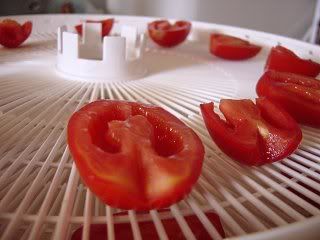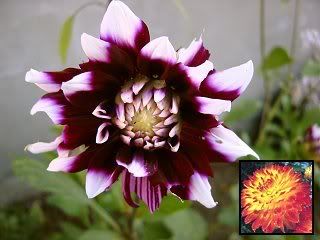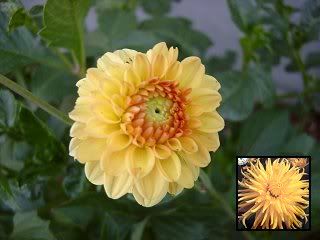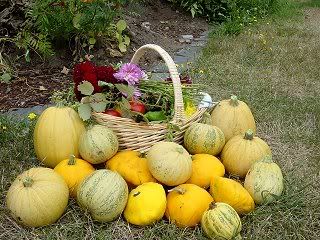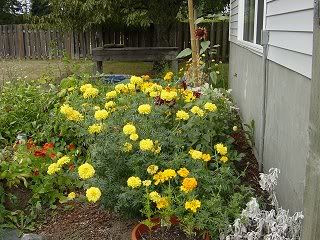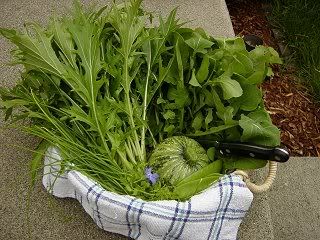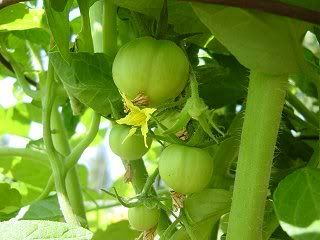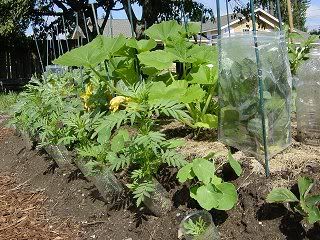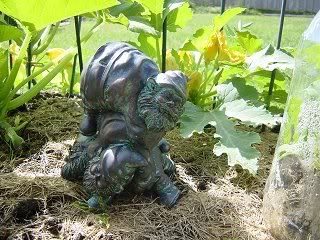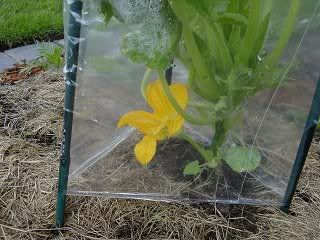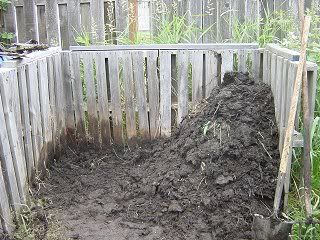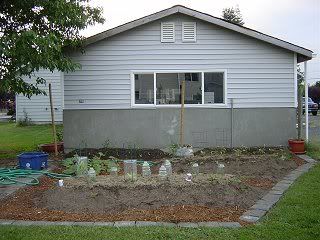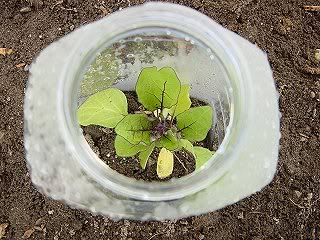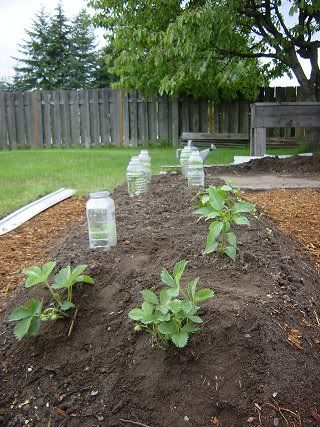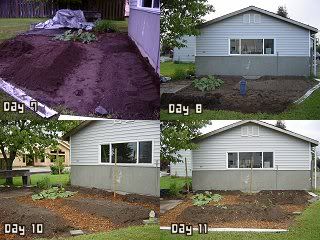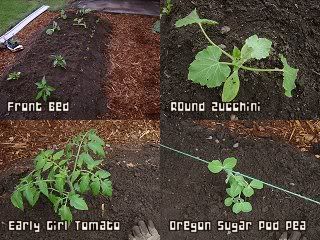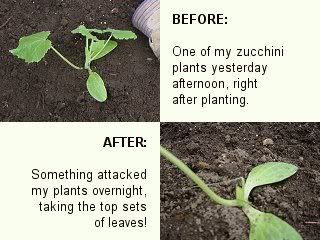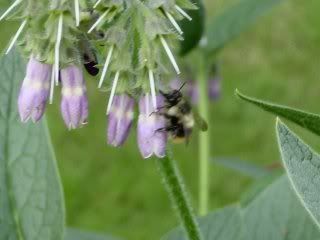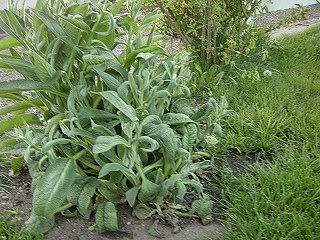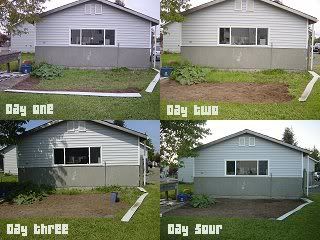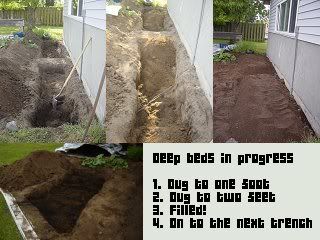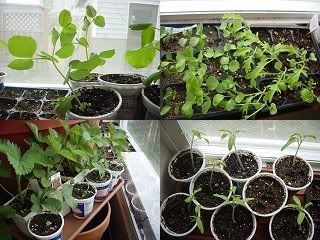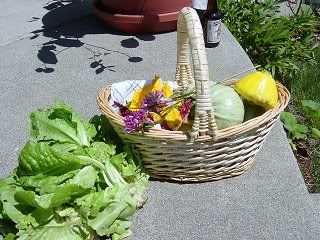
Summer has definitely arrived in Washington over the past two weeks! Temperatures are in the eighties during the day and the rain has slowed to an occasional sprinkling-- I've even had to water the garden a few times (the horror!) Meanwhile, the mizuna and arugula have bolted, the pea vines are yellowing and slowing down production, and the summer vegetables are taking off like there's no tomorrow.
Zucchini and yellow pattypan squash are my main crops at the moment; there is definitely zucchini bread in our future, and lots of it. The squash bed is lush and overbrimming. The eleven plants are yielding about four zucchini and two pattypan squash per day, and it looks like they're just getting started. Following Sillyduckie's suggestion, I finally broke down and made stuffed zucchini blossoms over the weekend; they disappeared almost instantaneously.
The eggplant and jalapeno plants (also in the squash bed) aren't doing quite as well; the eggplant gets dried out before anything else in the garden in this heat, although it's finally
flowering. Of the two
jalapeno plants, only the one furthest from the shade of the squash plants is setting fruit. There are about five baby jalapenos on the plant now, and it looks like there will be more before the season's done. Jalapeno poppers, yum!
Tomatoes still aren't ripening yet-- I'm keeping an eye on the earliest cluster of fruit, which has been growing steadily over the past month but not showing the least hint of reddening. At least I'm not alone; according to GardenWeb's forums, the only tomatoes ripening in our corner of the country are cherry tomatoes, which I neglected to plant. The good news, though, is that the
Roma and
Brandywine plants have finally set fruit, and the plants seem to have topped out in terms of height... the Early Girl is easily four feet high, and the Romas and Brandywines at least three feet high each.
The everbearing strawberries are small and runty and drying out as quickly as the eggplant! They will definitely need transplanting to a frequently watered spot at the end of the season. On the other hand, the oregano and thyme plants are flourishing, along with the basil, chives, and lemon thyme.
On the ornamental front: some
sweet peas that were planted back in late April have finally bloomed-- and they're all dark magenta. I guess that's okay, since the dahlias in that bed are also all dark magenta, with the exception of two pink cactus types ('Bonne Esprit')that we added this year. Actually, the hollyhocks in that bed (which haven't bloomed yet) are also going to be dark magenta... so apparently it's going to be a running theme.
Nasturtiums and marigolds are finally blooming as of this past week. The marigolds were definitely a surprise... the marigolds I'm used to are the short French type that don't get much more than nine inches high. The ones I planted (unbeknownst to me at the time) are an American type and two feet high. They work well in
bouquets, though, so it all seems to have turned out for the best.
The purple hydrangea in our front yard is finally starting to grow on me. It looked garish at first consideration, with its bright violet and magenta blooms, but this year I've discovered that before the flowers mature, they turn pretty shades of pink and periwinkle. And they last over a week as cut flowers-- definitely nice, since the dahlias don't seem to make it more than three or four days without drying out.
Finally, the garden is starting to flow over into the back porch. We bought a couple of
fuschias for two hanging baskets the previous owners left behind, and nasturtiums are coming up in a third hanging basket. A shaded two-foot
bowl planted just two weeks ago is already full of sprouting mesclun, and a
Meyer lemon tree that was suffering from spider mite damage indoors has started to sprout new leaves after a thorough water-spraying.
Here's the garden just two months after planting:
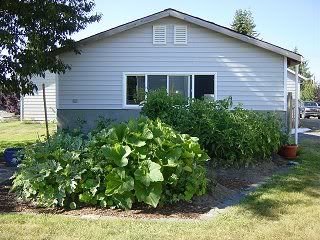
After speaking with my sister-in-law, a long-time vegetable gardener, I'm definitely scheming to expand the garden next year. She's been picking a hundred tomatoes a day in her Missouri garden, which is about three times the size of ours.
A hundred tomatoes a day! That's a whole lot of salsa!

